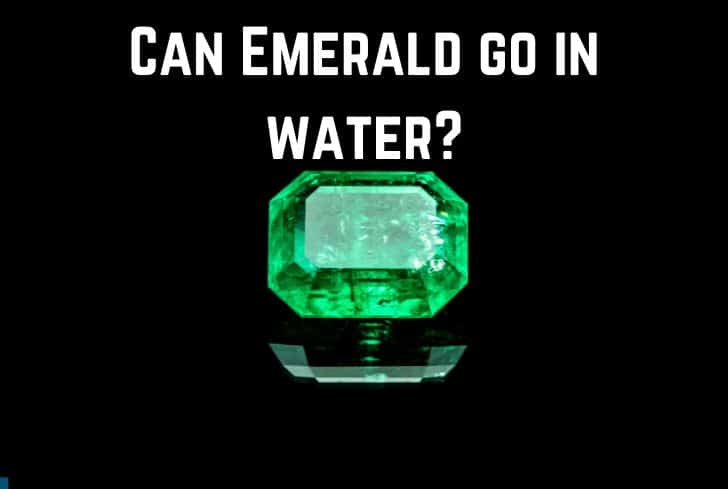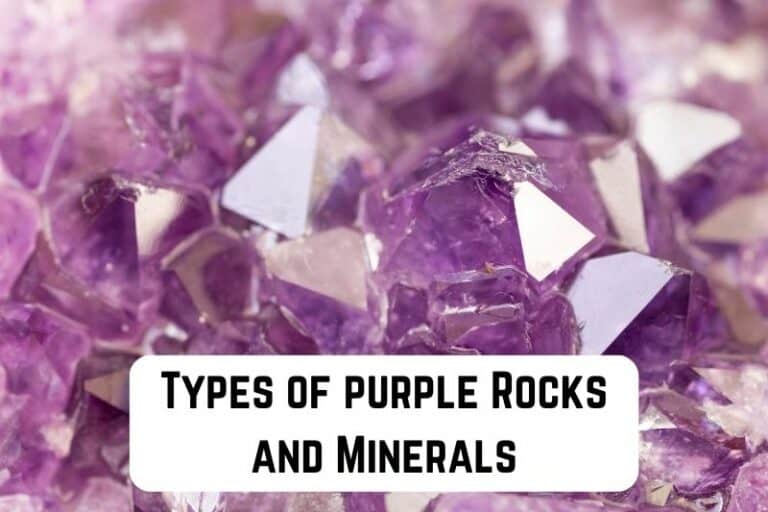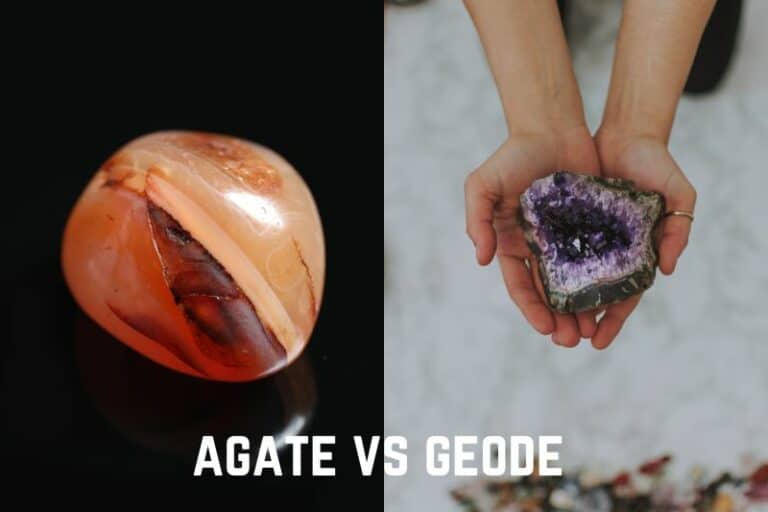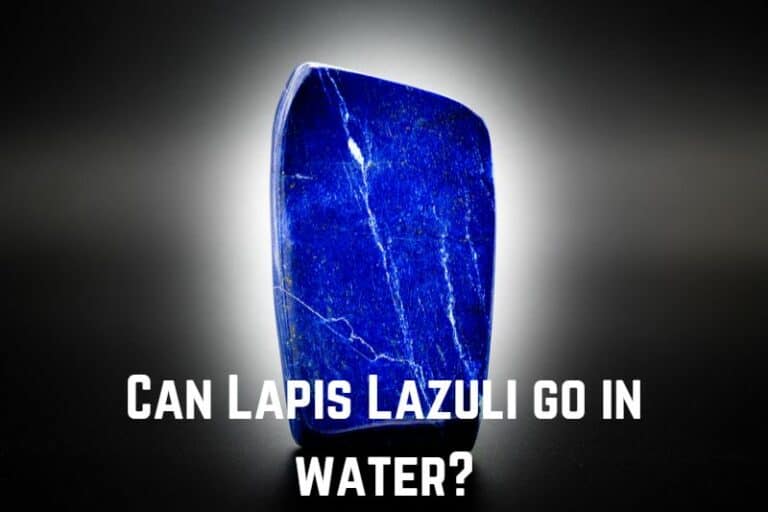Can Sodalite Go in the Water? (And in Salt?)

Sodalite is a tectosilicate mineral having a chemical formula Na8(Al6Si6O24)Cl2. It is best known for its royal blue color and is widely used as an ornamental gemstone. It is a member of the feldspathoid mineral group, and it gets its name due to its sodium content.
Have you ever wondered if Sodalite can go in the water? We will discuss that in this article. We will begin by talking about the properties of Sodalite. Then we will look at its interaction with salt and water. Finally, we will talk about cleaning and taking care of Sodalite.
Read: Can Carnelian go in Salt?
Is Sodalite Water Safe?
Sodalite can survive underwater but it is not recommended. Sodalite has a value of 5.5-6 on the Mohs Scale, which is above the minimum value required for minerals to be safe underwater. However, prolonged exposure to water can dull the surface and damage the stone.
Mohs Hardness Scale is a relative measure of a mineral’s resistance to scratching. Besides that, it also indicates a mineral’s relationship to water. Usually, a value of over 5.0 means that the mineral can survive underwater.
There are some soft stones like selenite which will dissolve when left in water. This will not happen with Sodalite, as it’s relatively harder, but it should still not be immersed for long.
Reasons Why Sodalite Should Not be Put in Water
Sodalite has a hardness of 5.5-6 on the Mohs Hardness Scale, meaning that it can survive underwater. However, like all stones, it should still not be immersed for long. Water encourages the creation of fissures and also tarnishes the appearance of the stone.
Here are the reasons why you shouldn’t put Sodalite in water:
- Damages the Stone: However, even for such stones, it is not advisable to soak them for long. Water enters the tiny crevices of stones and widens them. This leads to the creation of fissures, which may not be visible at first but can slowly damage the structure of the stone. The stone will then become more prone to breaking upon impact.
- Tarnishes Appearance: Stones are often polished with things like oil, which can get washed off when the stone is left in water for a long time. Fissures, encouraged by water, can also change the way light bounces off the stone, further ruining its appearance.
- Chemical Reaction: For some minerals, water can also react adversely with their components. For example, stones containing iron will react with water to create rust, which will irrevocably damage the stone. Sodalite can release aluminium into the water, which can be dangerous. So, it is best not to immerse stones in water for long.
What are the Properties of Sodalite?
Here are the properties of Sodalite:
- Appearance: Sodalite ranges from royal blue to violet-blue, usually with white veining. It can also come in grey, green, and red colors. Sodalite has a vitreous to greasy lustre, and its crystals are usually translucent to transparent.
- Composition: Sodalite is a member of the feldspathoid mineral group, which includes aluminosilicate minerals containing calcium, potassium, or sodium. Sodalite occurs in igneous rocks that have crystallized from sodium-rich magmas, hence its name.
- Structure: Sodalite has a cubic crystal system. It has a poor cleavage in six directions that is usually not apparent. Upon impact, it breaks by conchoidal fracture.
- Hardness: Sodalite has a value of 5.5-6 on the Mohs Hardness Scale. It can survive underwater but shouldn’t be immersed for long. Due to its relatively low hardness, Sodalite is usually not used in jewelry pieces that are prone to wear and tear.
- Differentiating Properties: Sodalite can often be confused with other minerals, especially lapis lazuli. What differentiates Sodalite from this mineral is its darker blue color and the absence of pyrite. Under UV light, Sodalite produces orange fluorescence, thus helping in its identification.
Because of its similarities to lapis lazuli, Sodalite can also be used as its alternative. It provides people with a similar vivid blue color and is significantly cheaper than lapis lazuli. Sodalite is found in Ontario (Canada), Arkansas (the US), and some parts of South America.
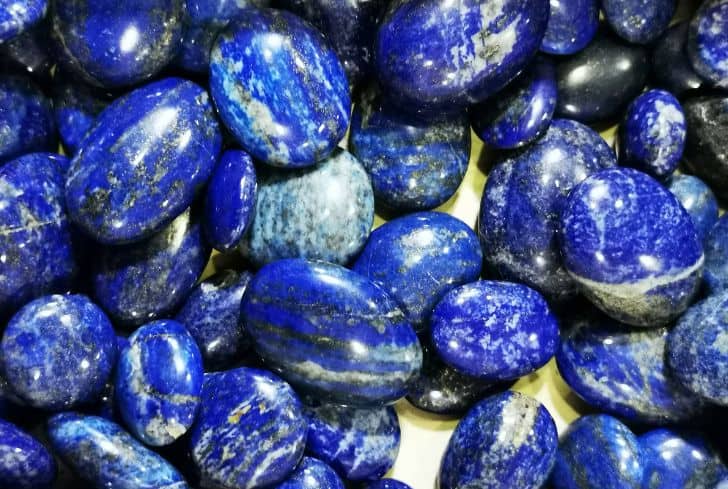
Can Sodalite go in Salt?
Yes, Sodalite can go in the salt. It has a value of 5.5-6 on the Mohs Scale, meaning that it is moderately resistant to scratches. Surface contact with salt will not harm the stone. However, one should never immerse Sodalite (like most minerals) into the salt water as that can be very damaging.
Salt has a value of 2.5 on the Mohs Hardness scale. Therefore, it cannot scratch Sodalite upon contact. Keeping stones in a bed of dry salt is a common way of recharging them.
Without water, salt cannot penetrate the crevices of the stone. As such, it cannot damage it in any way.
Read: Can Carnelian go in the Water?
Can Sodalite go in Salt Water?
No, Sodalite should not be put into salt water. Sodalite has a value of 5.5-6 on the Mohs Scale, meaning that it is safe underwater, but it should still not be immersed for too long. When the solution has salt, the corrosive process becomes even worse.
When dissolved in water, salt can penetrate the crevices of the stone. Here, it can widen the cracks and create fissures, which can damage the structure of the stone. In general, water also dulls the surface of stones, usually by stripping off their outer polish.
With minerals containing iron, salt water is particularly harmful. This is because salt hastens the process of rusting, damaging the stone even faster.
Can Sodalite go in Moon Water?
Sodalite can go in moon water, but it is not recommended. Although Sodalite has a hardness of 5.5-6 on the Mohs Scale, soaking it in water for prolonged periods can be dangerous because water can dull and damage the stone. Sodalite can also adversely react with the water.
Like all stones, sodalite should not be immersed in water for long. Water tends to enter the crevices of the stone, widening them, and thus damaging the structure of the stone. It can also dull the shine of the stone by stripping off its polish.
Moonwater is water that has been kept out during a full-moon night. The stone is then believed to be charged with the energies of the moon. While recharging stones with moon water is a popular method among crystal keepers, it is not recommended in the case of Sodalite.
Instead, you can try recharging your stone by keeping it out directly in the moonlight. Sunlight can also be used, but just keep in mind that the hackmanite variant of Sodalite has the property of tenebrescence.
This means that it changes color when exposed to light (UV or sunlight), and this is reversed when the light source is removed.
Can You Wear Sodalite in the Shower or Bath?
It is not recommended to wear Sodalite in the shower or bath. Sodalite has a value of 5.5-6 on the Mohs scale, so while it can survive underwater, it is not safe when immersed for long. Moreover, because of its relatively low hardness, Sodalite is also prone to other forms of damage.
If you wear your sodalite jewellery while bathing or showering, the stone will be regularly exposed to water. This can be harmful to the stone as the water can encourage fissures and damage the stone. It can also dull the gem’s glow.
It is better to take off your Sodalite jewellery when doing any physical activity like exercising, swimming, etc. Sodalite has a low hardness, and any impact can easily scratch its surface or break it altogether.
It is because of this low hardness that Sodalite is not used for jewelry that is prone to wear and tear, like rings or bracelets. Instead, it is mostly used in earrings, pendants, etc. Sodalite is also used to make cabochons, beads, and tumbled stones.
How to Clean and Care for Sodalite?
Follow these steps to clean Sodalite:
- Mix a mild detergent with warm water.
- Immerse the stone in the solution for a few minutes, while scrubbing its surface with a soft brush.
- Rinse the stone under running water, removing any excess soap.
- Let it air dry. You can turn the stone around to ensure that no water is left in the crevices.
Sodalite has a relatively low hardness of 5.5-6, so despite being tough, it can scratch easily. You must keep it separate from other pieces, as popular jewelry pieces like quartz or topaz will scratch it. Over time, household dust (7-7.5 on Mohs Scale) will also harm the stone.
Because of its low hardness, Sodalite is usually not used for jewelry pieces that are prone to wear and tear, like rings or bracelets. However, if you are doing so, use protective settings for the gem.
Conclusion
In this article, we have discussed Sodalite’s interaction with water. Given its relatively low hardness of 5.5-6, it is not recommended to immerse the stone in water for a long as it can damage the stone’s structure and dull its surface. We looked at the properties of Sodalite and also talked about its interaction with salt. Finally, we discussed how to take care of Sodalite.


